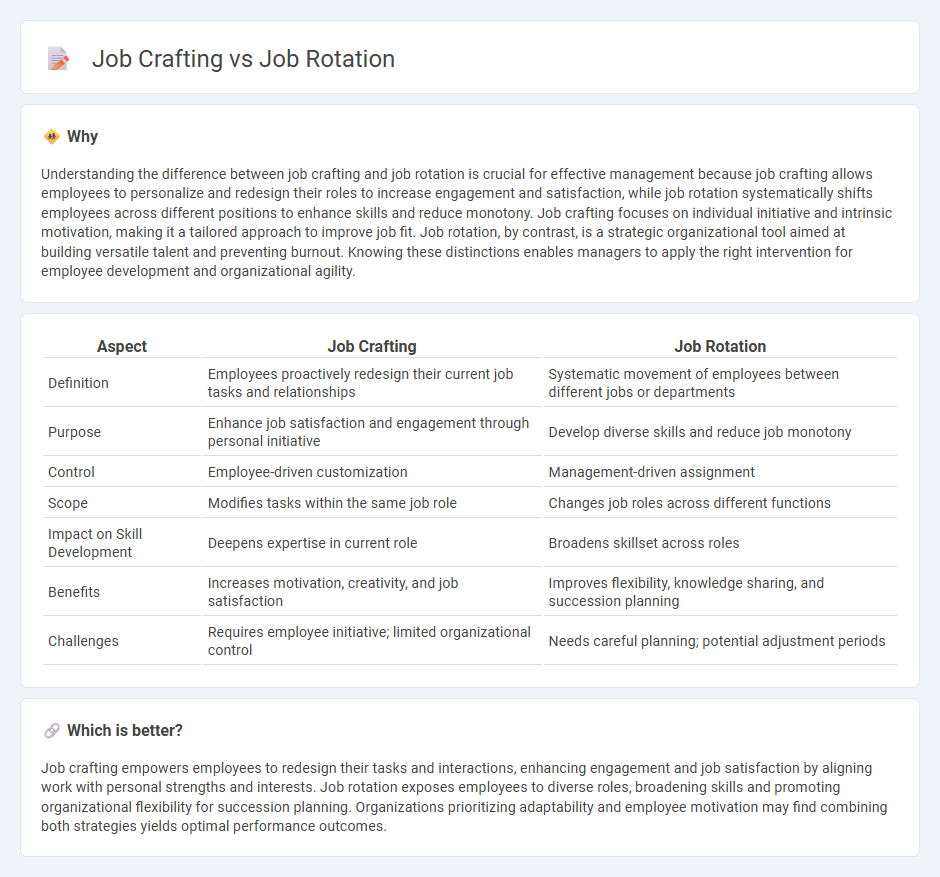
Job crafting involves employees tailoring their tasks and roles to better fit their strengths and interests, enhancing job satisfaction and performance. Job rotation systematically moves employees through different positions to develop a broader skill set and increase organizational knowledge. Explore how both strategies can optimize workforce engagement and productivity.
Why it is important
Understanding the difference between job crafting and job rotation is crucial for effective management because job crafting allows employees to personalize and redesign their roles to increase engagement and satisfaction, while job rotation systematically shifts employees across different positions to enhance skills and reduce monotony. Job crafting focuses on individual initiative and intrinsic motivation, making it a tailored approach to improve job fit. Job rotation, by contrast, is a strategic organizational tool aimed at building versatile talent and preventing burnout. Knowing these distinctions enables managers to apply the right intervention for employee development and organizational agility.
Comparison Table
| Aspect | Job Crafting | Job Rotation |
|---|---|---|
| Definition | Employees proactively redesign their current job tasks and relationships | Systematic movement of employees between different jobs or departments |
| Purpose | Enhance job satisfaction and engagement through personal initiative | Develop diverse skills and reduce job monotony |
| Control | Employee-driven customization | Management-driven assignment |
| Scope | Modifies tasks within the same job role | Changes job roles across different functions |
| Impact on Skill Development | Deepens expertise in current role | Broadens skillset across roles |
| Benefits | Increases motivation, creativity, and job satisfaction | Improves flexibility, knowledge sharing, and succession planning |
| Challenges | Requires employee initiative; limited organizational control | Needs careful planning; potential adjustment periods |
Which is better?
Job crafting empowers employees to redesign their tasks and interactions, enhancing engagement and job satisfaction by aligning work with personal strengths and interests. Job rotation exposes employees to diverse roles, broadening skills and promoting organizational flexibility for succession planning. Organizations prioritizing adaptability and employee motivation may find combining both strategies yields optimal performance outcomes.
Connection
Job crafting allows employees to reshape tasks, relationships, and perceptions of their roles, enhancing engagement and satisfaction, while job rotation systematically moves employees across different roles to develop diverse skills and reduce monotony. Both practices empower workforce adaptability and foster continuous learning by aligning individual strengths with organizational needs. Integrating job crafting with job rotation accelerates personal growth and optimizes talent utilization in dynamic management environments.
Key Terms
Task Variety
Job rotation enhances task variety by systematically moving employees across different roles to develop diverse skills and prevent monotony, while job crafting allows individuals to proactively redesign their current tasks to increase engagement and meaningfulness. Task variety in job rotation is structured and organizationally driven, promoting broad skill acquisition, whereas job crafting provides personalized control, tailoring tasks to fit employees' strengths and interests. Explore more about how task variety in these strategies can boost employee motivation and productivity.
Employee Autonomy
Job rotation enhances employee autonomy by systematically moving individuals across various roles, allowing them to develop diverse skills and reduce job monotony. Job crafting enables employees to proactively modify their tasks, relationships, and perceptions, fostering personalized job experiences that increase intrinsic motivation and engagement. Discover how implementing both strategies can optimize workforce flexibility and employee satisfaction in your organization.
Skill Development
Job rotation exposes employees to diverse roles, enhancing skill development by broadening their experience across different functions within the organization. Job crafting allows employees to customize their current roles to better align with their strengths and interests, fostering deeper skill refinement in specific areas. Explore how both strategies can be leveraged to maximize workforce potential and personal growth.
Source and External Links
Job Rotation - Wikipedia - Job rotation involves moving employees between jobs without a change in rank or salary, often to enhance skills and employee engagement.
Job Rotation | EBSCO Research Starters - Job rotation is a strategy to cross-train employees, reducing monotony and increasing skills across departments.
Job Rotation: A Full Guide with 5 Examples - AIHR - This guide provides examples and insights into job rotation programs, which are used to develop employee skills and improve workforce flexibility.
 dowidth.com
dowidth.com